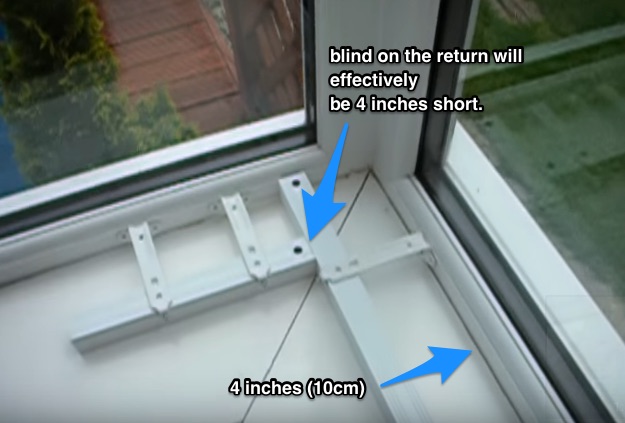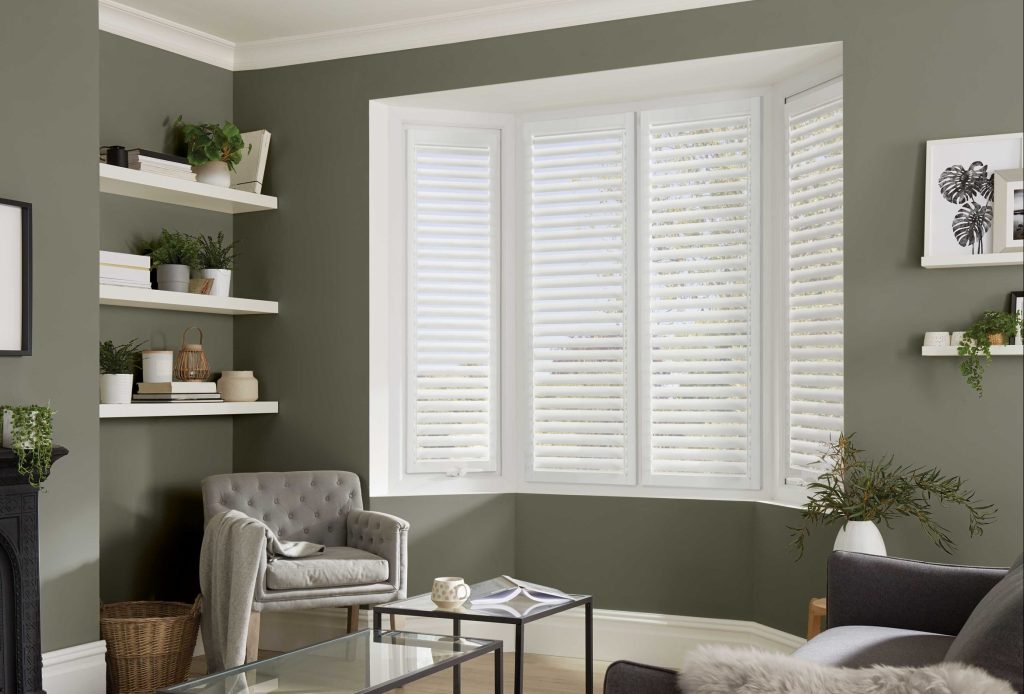Very few windows cause any problems when choosing new blinds with the exception of square bay windows. Often referred to as box bays, a square bay window is a 3 sided bay with the returns being at 90 degree right angles to the front window.
The problem arises due to the front to back depth of the blinds chosen. Let’s look at this example to illustrate what we mean.
The image below is a square bay window and you can see the headrails for vertical blinds laid out on the window board. You’ll notice that the rail for one window runs the full width whilst the adjacent rail butts up against it. There’s a distance on this example of vertical blinds of 4 inches or 10 cm.
This means that the blind that butts up to the main blind will be short by this amount.

Points To Consider When Choosing Blinds For Box Bays
Despite this obstacle that box bays present, there are quite a few blinds that fit square bays without an issue. Let’s take a look.
Roller Blinds For Square Bays
The beauty of roller blinds is that they can have the fabric roll either from the rear or the front. Because of this feature, Any potential gap can be reduced dramatically when the blinds are fitted. This makes them ideal for box bays.
Vertical Blinds For Square Bays
Vertical blinds are also ideal for square bays, again this is because when they’re closed, they sit at right angles to each other. The wider the slat on the blinds, the better as this will help to fill the void that exists in the corner where the rails meet. Vertical blinds are always a popular choice for box bay windows.
Venetian Blinds For Square Bays
Traditional aluminium venetian blinds are usually a good choice for square bays. The reason for this is quite simple. A typical width slat is just 25mm. This also means that that the headrail is slim, very slim and so unlike the vertical blind example above, the gap in the corner is much smaller. Most bay windows have at least 3 inches of visible window frame in the corner.
Wood venetian blinds pose a different problem. Usually, wood blinds have large slat widths, very often 50 or 60mm. As you can imagine, this means that the offset is quite large where the two blinds but up. Much like the image of the venetian blind rails earlier on in this post.
When the blinds are open, this doesn’t pose a problem, it’s only when the blinds are closed that the offset becomes apparent. Venetian blinds close flat, and when they are closed, there is nothing to disguise the gap caused by the two blinds being butted up. See the image below.

Not a great deal can be done about this. Older bays generally have thicker window frames and so hide the gap well, Newer PVCu windows however tend to be much slimmer and so the problem appears worse.
Plantation Shutters For Box Bays
Plantation shutters are enclosed in their own subframe. As such, they don’t suffer from this problem at all. Once closed, there are no gaps and so from a privacy viewpoint, shutters offer the best solution.
Perfect Fit Blinds For Box Bay Windows
To overcome all of the problems listed above, perhaps the best solution for bay windows are Perfect Fit Blinds or Shutters. These clever blinds don’t require any screws as they attach via brackets that slide behind the gaskets of PVCu windows and doors. Available in a huge range including Venetian, roller, pleated and even perfect fit shutters, Perfect Fit blinds are the ideal solution for bay and bow windows, providing the ultimate in privacy, security and light control.

Our fitters are happy to advise. We offer a free measure and blind quotation, Click here to book an appointment.





